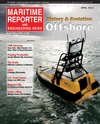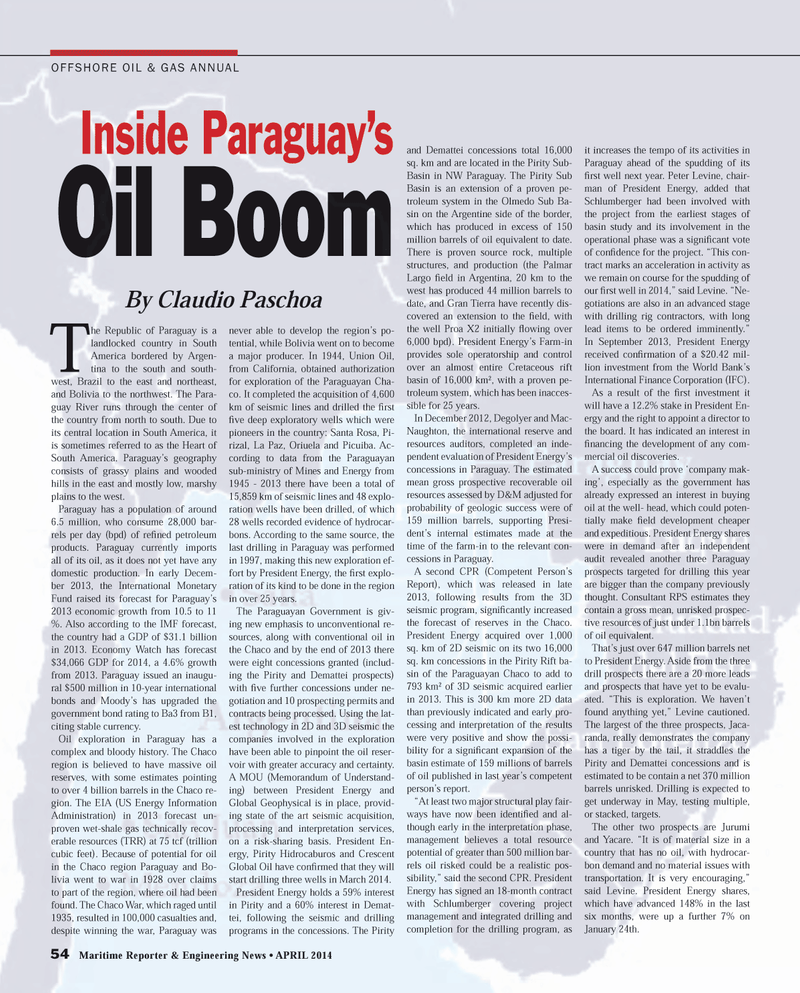
Page 54: of Maritime Reporter Magazine (April 2014)
Offshore Edition
Read this page in Pdf, Flash or Html5 edition of April 2014 Maritime Reporter Magazine
The Republic of Paraguay is a landlocked country in South America bordered by Argen- tina to the south and south-west, Brazil to the east and northeast, and Bolivia to the northwest. The Para- guay River runs through the center of the country from north to south. Due to its central location in South America, it is sometimes referred to as the Heart of South America. Paraguay?s geography consists of grassy plains and wooded hills in the east and mostly low, marshy plains to the west.Paraguay has a population of around 6.5 million, who consume 28,000 bar- rels per day (bpd) of reÞ ned petroleum products. Paraguay currently imports all of its oil, as it does not yet have any domestic production. In early Decem-ber 2013, the International Monetary Fund raised its forecast for Paraguay?s 2013 economic growth from 10.5 to 11 %. Also according to the IMF forecast, the country had a GDP of $31.1 billion in 2013. Economy Watch has forecast $34,066 GDP for 2014, a 4.6% growth from 2013. Paraguay issued an inaugu-ral $500 million in 10-year international bonds and Moody?s has upgraded the government bond rating to Ba3 from B1, citing stable currency. Oil exploration in Paraguay has a complex and bloody history. The Chaco region is believed to have massive oil reserves, with some estimates pointing to over 4 billion barrels in the Chaco re-gion. The EIA (US Energy Information Administration) in 2013 forecast un-proven wet-shale gas technically recov-erable resources (TRR) at 75 tcf (trillion cubic feet). Because of potential for oil in the Chaco region Paraguay and Bo-livia went to war in 1928 over claims to part of the region, where oil had been found. The Chaco War, which raged until 1935, resulted in 100,000 casualties and, despite winning the war, Paraguay was never able to develop the region?s po- tential, while Bolivia went on to become a major producer. In 1944, Union Oil, from California, obtained authorization for exploration of the Paraguayan Cha-co. It completed the acquisition of 4,600 km of seismic lines and drilled the Þ rst Þ ve deep exploratory wells which were pioneers in the country: Santa Rosa, Pi-rizal, La Paz, Oriuela and Picuiba. Ac- cording to data from the Paraguayan sub-ministry of Mines and Energy from 1945 - 2013 there have been a total of 15,859 km of seismic lines and 48 explo-ration wells have been drilled, of which 28 wells recorded evidence of hydrocar- bons. According to the same source, the last drilling in Paraguay was performed in 1997, making this new exploration ef-fort by President Energy, the Þ rst explo-ration of its kind to be done in the region in over 25 years. The Paraguayan Government is giv-ing new emphasis to unconventional re-sources, along with conventional oil in the Chaco and by the end of 2013 there were eight concessions granted (includ-ing the Pirity and Demattei prospects) with Þ ve further concessions under ne- gotiation and 10 prospecting permits and contracts being processed. Using the lat-est technology in 2D and 3D seismic the companies involved in the exploration have been able to pinpoint the oil reser- voir with greater accuracy and certainty. A MOU (Memorandum of Understand- ing) between President Energy and Global Geophysical is in place, provid-ing state of the art seismic acquisition, processing and interpretation services, on a risk-sharing basis. President En-ergy, Pirity Hidrocaburos and Crescent Global Oil have conÞ rmed that they will start drilling three wells in March 2014. President Energy holds a 59% interest in Pirity and a 60% interest in Demat-tei, following the seismic and drilling programs in the concessions. The Pirity and Demattei concessions total 16,000 sq. km and are located in the Pirity Sub-Basin in NW Paraguay. The Pirity Sub Basin is an extension of a proven pe-troleum system in the Olmedo Sub Ba-sin on the Argentine side of the border, which has produced in excess of 150 million barrels of oil equivalent to date. There is proven source rock, multiple structures, and production (the Palmar Largo Þ eld in Argentina, 20 km to the west has produced 44 million barrels to date, and Gran Tierra have recently dis- covered an extension to the Þ eld, with the well Proa X2 initially ß owing over 6,000 bpd). President Energy?s Farm-in provides sole operatorship and control over an almost entire Cretaceous rift basin of 16,000 km², with a proven pe-troleum system, which has been inacces-sible for 25 years.In December 2012, Degolyer and Mac-Naughton, the international reserve and resources auditors, completed an inde-pendent evaluation of President Energy?s concessions in Paraguay. The estimated mean gross prospective recoverable oil resources assessed by D&M adjusted for probability of geologic success were of 159 million barrels, supporting Presi-dent?s internal estimates made at the time of the farm-in to the relevant con-cessions in Paraguay. A second CPR (Competent Person?s Report), which was released in late 2013, following results from the 3D seismic program, signiÞ cantly increased the forecast of reserves in the Chaco. President Energy acquired over 1,000 sq. km of 2D seismic on its two 16,000 sq. km concessions in the Pirity Rift ba-sin of the Paraguayan Chaco to add to 793 km² of 3D seismic acquired earlier in 2013. This is 300 km more 2D data than previously indicated and early pro-cessing and interpretation of the results were very positive and show the possi-bility for a signiÞ cant expansion of the basin estimate of 159 millions of barrels of oil published in last year?s competent person?s report. ?At least two major structural play fair- ways have now been identiÞ ed and al- though early in the interpretation phase, management believes a total resource potential of greater than 500 million bar- rels oil risked could be a realistic pos-sibility,? said the second CPR. President Energy has signed an 18-month contract with Schlumberger covering project management and integrated drilling and completion for the drilling program, as it increases the tempo of its activities in Paraguay ahead of the spudding of its Þ rst well next year. Peter Levine, chair- man of President Energy, added that Schlumberger had been involved with the project from the earliest stages of basin study and its involvement in the operational phase was a signiÞ cant vote of conÞ dence for the project. ?This con- tract marks an acceleration in activity as we remain on course for the spudding of our Þ rst well in 2014,? said Levine. ?Ne- gotiations are also in an advanced stage with drilling rig contractors, with long lead items to be ordered imminently.? In September 2013, President Energy received conÞ rmation of a $20.42 mil- lion investment from the World Bank?s International Finance Corporation (IFC). As a result of the Þ rst investment it will have a 12.2% stake in President En-ergy and the right to appoint a director to the board. It has indicated an interest in Þ nancing the development of any com- mercial oil discoveries. A success could prove ?company mak- ing?, especially as the government has already expressed an interest in buying oil at the well- head, which could poten-tially make Þ eld development cheaper and expeditious. President Energy shares were in demand after an independent audit revealed another three Paraguay prospects targeted for drilling this year are bigger than the company previously thought. Consultant RPS estimates they contain a gross mean, unrisked prospec-tive resources of just under 1.1bn barrels of oil equivalent. That?s just over 647 million barrels net to President Energy. Aside from the three drill prospects there are a 20 more leads and prospects that have yet to be evalu-ated. ?This is exploration. We haven?t found anything yet,? Levine cautioned. The largest of the three prospects, Jaca- randa, really demonstrates the company has a tiger by the tail, it straddles the Pirity and Demattei concessions and is estimated to be contain a net 370 million barrels unrisked. Drilling is expected to get underway in May, testing multiple, or stacked, targets. The other two prospects are Jurumi and Yacare. ?It is of material size in a country that has no oil, with hydrocar- bon demand and no material issues with transportation. It is very encouraging,? said Levine. President Energy shares, which have advanced 148% in the last six months, were up a further 7% on January 24th.Inside Paraguay?s Oil BoomOil BoomBy Claudio PaschoaOFFSHORE OIL & GAS ANNUAL 54 Maritime Reporter & Engineering News ? APRIL 2014 MR #4 (50-55).indd 54MR #4 (50-55).indd 544/5/2014 3:31:59 PM4/5/2014 3:31:59 PM

 53
53

 55
55
